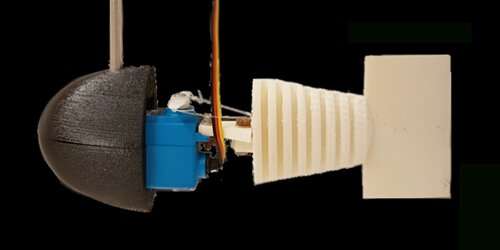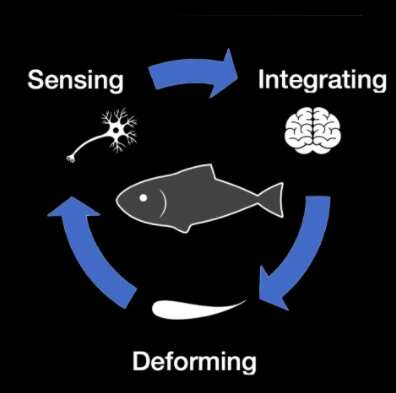June 29, 2021 feature
A proprioceptive mechanism to enable fish-like swimming in robots

Over the past few decades, roboticists have developed a variety of robots inspired by nature, humans and animals. To effectively mimic animals or humans, however, these robots should not only look like them; they should also move in similar ways.
Researchers at Université Côte d'Azur- CNRS have recently introduced a new bioinspired mechanism to achieve fish-like swimming in robots. This mechanism, introduced in a paper published in Physical Review Letters, is based on what is known as proprioception, the ability of animals to gather information about their bodies' position, motion and acceleration.
"With my colleagues M. Gazzola and L. Mahadevan, we have uncovered a general law that predicts the velocity of macroscopic underwater swimmers as a function of the swimming gait, i.e., the amplitude and the frequency of the fin/tail stroke," Mederic Argentina, one of the researchers who carried out the study, told Phys.org. "Our work provided a rational explanation of this scaling law which worked on swimmers of a few centimetre length to the largest animals, such as blue whales (30m)."
To test their model, the researchers wanted to collect kinematic data of tail undulation, which has not yet been measured in living animals. In addition, they were curious to understand what mechanisms allow a given swimmer to select the amplitude and frequency of its tail's motion. To achieve this, they built a small compliant robot with a body that can biomimetically deform.
"This robotic platform allowed us to validate our scaling law, but also to explore scenarios for the selection of the undulation kinematics," Argentina said. "It seemed natural that proprioception should be an excellent candidate, as it is a sense (sometimes called as the sixth sense) that evaluates body deformation, its acceleration or the felt force. In our recent paper, we questioned whether a feedback loop controlled by proprioception could trigger locomotion and our work demonstrated that indeed proprioceptive sensors can induce a nice and steady swimming."

The primary advantage of the proprioceptive mechanism introduced by Argentina and his colleagues is that it allows robotic swimmers to adapt their undulation to their surrounding environment, just as many fish do. In fact, most fish have lateral lines that can measure the pressure of fluid on their body, allowing them to integrate proprioceptive senses.
"Our idea was to exploit the feedback the felt force of the robot to the deformation of the tail," Argentina said. "This approach is thus simple, robust and might explain the selection of the swimming gaits."
The researchers tested the proprioceptive mechanism they developed on a real biomimetic robot, comparing its performance with that it attained when utilizing a generic model for robotic swimming. Their findings were highly promising, as their mechanism compared favorably with the generic model and enabled fish-like swimming in the robot.
"Proprioception can also be the first step to create undulating robots which automatically tune their kinematics to the environment," Argentina said. "Our work demonstrated that this simple coupling of proprioception to tail movement could trigger an instability that yields the tail to undulate and thrusts the swimmer."
In the future, the proprioceptive mechanism devised by this team of researchers could enable the development of aquatic robots that can move more effectively in water. Meanwhile, Argentina and his colleagues will continue to work on their robot to enhance its capabilities.
"We are currently teaching the robot to swim using machine learning techniques," Argentina said. "Our first results give us a lot of confidence that we should be able to construct/design undulating robots that swim using AI."
More information: Proprioceptive mechanism for bioinspired fish swimming. Physical Review Letters(2021). DOI: 10.1103/PhysRevLett.126.234501.
Journal information: Physical Review Letters
© 2021 Science X Network





















